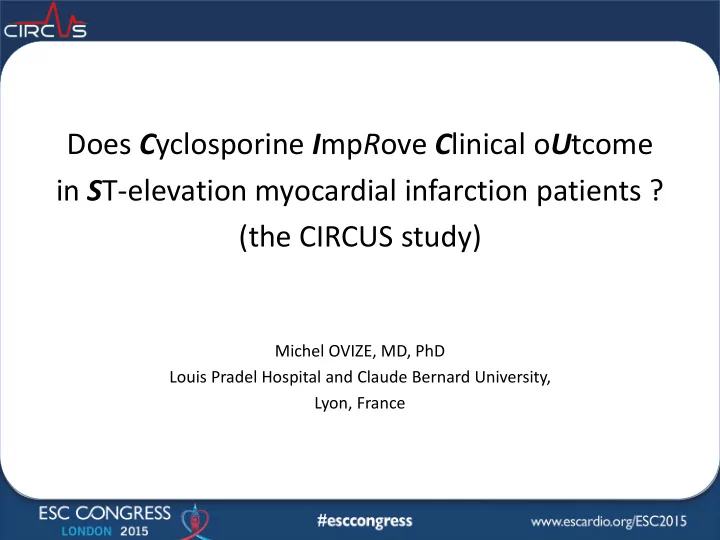

Does C yclosporine I mp R ove C linical o U tcome in S T-elevation myocardial infarction patients ? (the CIRCUS study) Michel OVIZE, MD, PhD Louis Pradel Hospital and Claude Bernard University, Lyon, France
Neurovive Pharmaceuticals, AB:
Reperfusion injury contributes to myocardial infarction AMBULANCE PCI CARDIOLOGIST Onset of First medical Cath lab PCI Reperfusion chest pain care admission 30 minutes to 12 hours Ischemia injury CORONARY ARTERY OCCLUSION - TIMI flow grade =0-1 WINDOW TO START TREATMENT OF REPERFUSION INJURY Reperfusion injury Ischemia / Reperfusion REPERFUSION NECROSIS ATP Pi Ca2+ ROS Transition pore - Ca 2+ Cyclosporine Mitochondria
Phase II trial: cyclosporine reduces infarct size in STEMI CMR infarct size Cyclosporine (or saline) STEMI < 12 hrs Day 1-3 (2.5 mg/kg, IV bolus) PCI treatment CK / TnI release TIMI flow grade 0-1 Infarct size No visible collateral Day 5 MRI Direct stenting 120 6000 CK release Control area of hyperenhancement (g) Cyclo 70 5000 60 (UI/L) 4000 50 3000 * 40 2000 30 1000 20 10 0 0 control cyclosporine Piot et al. NEJM 2008
CIRCUS (phase III trial) : objective and endpoints OBJECTIVE To determine whether cyclosporine might improve clinical outcome in STEMI patients PRIMARY ENDPOINT Combined incidence within 1 year after STEMI of : [ all-cause mortality; worsening of heart failure during initial hospitalization or re-hospitalisation for heart failure ; LV remodeling ] (LV remodeling (echo): increase > 15% of LVEDV at 1 year versus initial discharge)
Study population and recruitment • 18 years • symptom onset < 12 hrs Anterior STEMIs • ST shift e 0.2 mV in two contiguous anterior leads • LAD as culprit artery with TIMI flow grade : 0 – 1 Randomized (n= 970) Cyclosporine Control ITT Analysis (n = 475) (n=495) No informed content (n=1) Did not receive any treatment (n=4) Imprisoned and therefore ineligible (n=1) Missing or poor echographic data Did not receive any treatment (n=4) (n=95) Missing or poor echographic data (n=74) Primary endpoint Cyclosporine Control Analysis (n = 395) (n=396) 42 investigation centres in 3 countries 1000 900 First patient included : 2011 April, 19 Last patient included : 2014 February, 16 800 Last visit last patient : 2015 April 2 nd 700 Number of patients enrolled 600 500 400 Cumulative inclusions 300 Target enrollement 200 100 0 février-11 mars-11 avril-11 mai-11 juin-11 juillet-11 août-11 septembre-11 octobre-11 novembre-11 décembre-11 janvier-12 février-12 mars-12 avril-12 mai-12 juin-12 juillet-12 août-12 septembre-12 octobre-12 novembre-12 décembre-12 janvier-13 février-13 mars-13 avril-13 mai-13 juin-13 juillet-13 août-13 septembre-13 octobre-13 novembre-13 décembre-13 janvier-14 février-14
Primary and secondary outcomes at 1 year Cyclosporine Control Odds Ratio P value (n=395) (n=396) (95% CI) (Death / HF / LV remodeling) 233 ( 59.0 % ) 230 ( 58.1% ) 1.04 [0.78; 1.39] 0.77 1.09 Death: all-cause 7.1 % 6.6 % 0.76 [0.63 ; 1.90] 1.01 Death: cardiovascular 6.1 % 6.1 % 0.98 [0.56 ; 1.81] HF worsening or re-hospitalization for 1.01 22.8 % 22.7 % 0.97 HF [0.72 ; 1.41] 0.92 HF worsening 15.7 % 16.9 % 0.65 [0.63 ; 1.34] 1.03 Re-hospitalization for HF 10.6 % 10.4 % 0.89 [0.65 ; 1.63] 1.09 LV remodeling 42.8 % 40.7 % 0.53 [0.82 ; 1.46] 1.09 Cardiogenic shock 6.6 % 6.1 % 0.77 [0.61 ; 1.94] 0.59 Recurrent Myocardial infarction 2.3 % 3.8 % 0.22 [0.26 ; 1.37] 0.58 Stroke 1.8 % 3.0 % 0.25 [0.22 ; 1.48] 0.73 Major bleeding 1.8 % 2.3 % 0.54 [0.27 ; 2.00]
Conclusion In anterior STEMI, cyclosporine did not reduce the risk of the composite outcome - One out of four patients died or was hospitalized for heart failure despite receiving state-of-the-art medical care. - Despite the results of CIRCUS, the concept that reperfusion injury is clinically important. The impact on clinical outcome of recent encouraging phase II trials remains however to be determined.
Recommend
More recommend